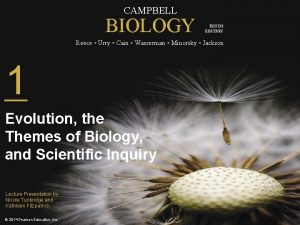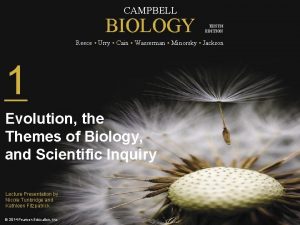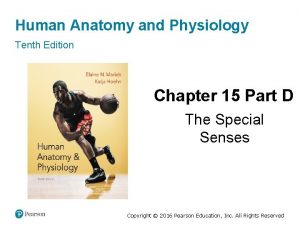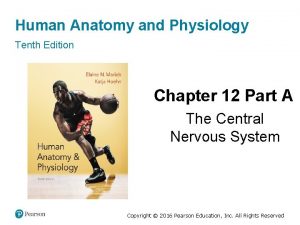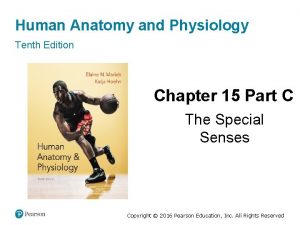Human Anatomy and Physiology Tenth Edition Chapter 15







































































- Slides: 71

Human Anatomy and Physiology Tenth Edition Chapter 15 Part B The Special Senses Copyright © 2016 Pearson Education, Inc. All Rights Reserved

15. 2 Focusing and Light Overview: Light and Optics • Wavelength and color – Electromagnetic radiation: all energy waves, from long radio waves to short X rays; visible light occupies a small portion in the middle of the spectrum § Light has wavelengths between 400 and 700 nm – Eyes respond only to visible light Copyright © 2016 Pearson Education, Inc. All Rights Reserved

Figure 15. 10 a the Electromagnetic Spectrum and Photoreceptor Sensitivities Copyright © 2016 Pearson Education, Inc. All Rights Reserved

Overview: Light and Optics (1 of 3) • Wavelength and color – Light: packets of energy (photons or quanta) that travel in wavelike fashion at high speeds – When visible light passes through spectrum, it is broken up into bands of colors (rainbow) § Red wavelengths are longest and have lowest energy, and violet are shortest and have most energy – Color that eye perceives is a reflection of that wavelength § Grass is green because it absorbs all colors except green § White reflects all colors, and black absorbs all colors Copyright © 2016 Pearson Education, Inc. All Rights Reserved

Figure 15. 10 b the Electromagnetic Spectrum and Photoreceptor Sensitivities Copyright © 2016 Pearson Education, Inc. All Rights Reserved

Overview: Light and Optics (2 of 3) • Refraction and lenses – Refraction: bending of light rays § Due to change in speed of light when it passes from one transparent medium to another and path of light is at an oblique angle – Example: from liquid to air § Lenses of eyes can also refract light because they are curved on both sides – Convex: thicker in center than at edges – Concave: thicker at edges than in center Copyright © 2016 Pearson Education, Inc. All Rights Reserved

Figure 15. 11 Refraction Copyright © 2016 Pearson Education, Inc. All Rights Reserved

Overview: Light and Optics (3 of 3) • Refraction and lenses – Convex lenses bend light passing through it, so that rays converge at focal point § Image formed at focal point is upside-down and reversed from left to right – Concave lenses disperse light, preventing light from being focused Copyright © 2016 Pearson Education, Inc. All Rights Reserved

Figure 15. 12 Light Is Focused by a Convex Lens Copyright © 2016 Pearson Education, Inc. All Rights Reserved

Focusing Light on the Retina (1 of 5) • Pathway of light entering eye: cornea, aqueous humor, lens, vitreous humor, entire neural layer of retina, and finally photoreceptors • Light is refracted three times along path: (1) entering cornea, (2) entering lens, and (3) leaving lens • Majority of refractory power is in cornea; however, it is constant and cannot change focus Copyright © 2016 Pearson Education, Inc. All Rights Reserved

Focusing Light on the Retina (2 of 5) • Lens is able to adjust its curvature to allow for fine focusing – Can focus for distant vision and for close vision Copyright © 2016 Pearson Education, Inc. All Rights Reserved

Figure 15. 13 a Focusing for Distant and Close Vision Copyright © 2016 Pearson Education, Inc. All Rights Reserved

Focusing Light on the Retina (3 of 5) • Focusing for distant vision – Eyes are best adapted for distant vision – Far point of vision: distance beyond which no change in lens shape is needed for focusing § 20 feet for emmetropic (normal) eye § Cornea and lens focus light precisely on retina at this distance – Ciliary muscles are completely relaxed in distance vision, which causes a pull on ciliary zonule; as a result, lenses are stretched flat Copyright © 2016 Pearson Education, Inc. All Rights Reserved

Figure 15. 13 b Focusing for Distant and Close Vision Copyright © 2016 Pearson Education, Inc. All Rights Reserved

Focusing Light on the Retina (4 of 5) • Focusing for close vision – Light from close objects (<6 m) diverges as approaches eye – Requires eye to make active adjustments using three simultaneous processes: 1. Accommodation of the lenses – Changing lens shape to increase refraction – Near point of vision • Closest point on which the eye can focus – Presbyopia: loss of accommodation over age 50 Copyright © 2016 Pearson Education, Inc. All Rights Reserved

Focusing Light on the Retina (5 of 5) 2. Constriction of the pupils § Accommodation pupillary reflex involves constriction of pupils to prevent most divergent light rays from entering eye – Mediated by parasympathetic nervous system 3. Convergence of the eyeballs § Medial rotation of eyeballs causes convergence of eyes toward object being viewed – Controlled by somatic motor neuron innervation on medial rectus muscles Copyright © 2016 Pearson Education, Inc. All Rights Reserved

Figure 15. 13 c Focusing for Distant and Close Vision Copyright © 2016 Pearson Education, Inc. All Rights Reserved

Clinical – Homeostatic Imbalance 15. 8 • Problems associated with refraction related to eyeball shape: – Myopia (nearsightedness) § Eyeball is too long, so focal point is in front of retina § Corrected with a concave lens – Hyperopia (farsightedness) § Eyeball is too short, so focal point is behind retina § Corrected with a convex lens – Astigmatism § Unequal curvatures in different parts of cornea or lens § Corrected with cylindrically ground lenses or laser procedures Copyright © 2016 Pearson Education, Inc. All Rights Reserved

Figure 15. 14 -1 Problems of Refraction Copyright © 2016 Pearson Education, Inc. All Rights Reserved

Figure 15. 14 -2 Problems of Refraction Copyright © 2016 Pearson Education, Inc. All Rights Reserved

15. 3 Phototransduction (1 of 3) Functional Anatomy of Photoreceptors • Photoreceptors (rods and cones) are modified neurons that resemble upside-down epithelial cells • Consists of cell body, synaptic terminal, and two segments: – Outer segment: light-receiving region § Contains visual pigments (photopigments) that change shape as they absorb light – Inner segment of each joins cell body § Inner segment is connected via cilium to outer segment and to cell body via outer fiber Copyright © 2016 Pearson Education, Inc. All Rights Reserved

15. 3 Phototransduction (2 of 3) – Cell body is connected to synaptic terminal via inner fibers – Plasma membrane of outer segment folds back to form many discs § Photopigments are embedded in discs Copyright © 2016 Pearson Education, Inc. All Rights Reserved

15. 3 Phototransduction (3 of 3) • Photoreceptors are vulnerable to damage – Degenerate if retina detached – Destroyed by intense light – Vision is maintained because outer segment is renewed every 24 hours § Tips fragment off and are phagocytized Copyright © 2016 Pearson Education, Inc. All Rights Reserved

Figure 15. 15 a Photoreceptors of the Retina Copyright © 2016 Pearson Education, Inc. All Rights Reserved

Comparing Rod and Cone Vision (1 of 2) • Rods are very sensitive to light, making them best suited for night vision and peripheral vision – Contain a single pigment, so vision is perceived in gray tones only – Pathways converge, causing fuzzy, indistinct images § As many as 100 rods may converge into one ganglion Copyright © 2016 Pearson Education, Inc. All Rights Reserved

Comparing Rod and Cone Vision (2 of 2) • Cones have low sensitivity, so require bright light for activation – React more quickly than rods – Have one of three pigments, which allow for vividly colored sight – Nonconverging pathways result in detailed, highresolution vision § Some cones have their own ganglion cell, so brain can put together accurate, high-acuity resolution images Copyright © 2016 Pearson Education, Inc. All Rights Reserved

Table 15. 1 Comparison of Rods and Cones Rods Cones Noncolor vision (one visual pigment) Color vision (three visual pigments) High sensitivity; function in dim light Low sensitivity; function in bright light Low acuity (many rods converge onto one ganglion cell) High acuity (one cone per ganglion cell in fovea) More numerous (20 rods for every cone) Less numerous Mostly in peripheral retina Mostly in central retina Copyright © 2016 Pearson Education, Inc. All Rights Reserved

Clinical – Homeostatic Imbalance 15. 9 • Color blindness: lack of one or more cone pigments • Inherited as an X-linked condition, so more common in males – As many as 8– 10% of males have some form • The most common type is red-green, in which either red cones or green cones are absent – Depending on which cone is missing, red can appear green, or vice versa – Rely on different shades to get cues of color Copyright © 2016 Pearson Education, Inc. All Rights Reserved

Visual Pigments (1 of 2) • Retinal: key light-absorbing molecule that combines with one of four proteins (opsins) to form visual pigments – Synthesized from vitamin A – Four opsins are rhodopsin (found in rods only), and three found in cones: green, blue, red (depending on wavelength of light they absorb) – Cone wavelengths do overlap, so same wavelength may trigger more than one cone, enabling us to see variety of hues of colors § Example: yellow light stimulates red and green cones, but if more red are triggered, we see orange Copyright © 2016 Pearson Education, Inc. All Rights Reserved

Visual Pigments (2 of 2) – Retinal isomers are different 3 -D forms § Retinal is in a bent form in dark, but when pigment absorbs light, it straightens out – Bent form called 11 -cis-retinal – Straight form called all-trans-retinal § Conversion of bent to straight initiates reactions that lead to electrical impulses along optic nerve Copyright © 2016 Pearson Education, Inc. All Rights Reserved

Figure 15. 15 b Photoreceptors of the Retina Copyright © 2016 Pearson Education, Inc. All Rights Reserved

Phototransduction (1 of 3) • Phototransduction: process by which pigment captures photon of light energy, which is converted into a graded receptor potential • Capturing light – Deep purple pigment of rods is rhodopsin § Arranged in rod’s outer segment § Three steps of rhodopsin formation and breakdown: – Pigment synthesis, pigment bleaching, and pigment regeneration – Similar process in cones, but different types of opsins and cones require more intense light Copyright © 2016 Pearson Education, Inc. All Rights Reserved

Phototransduction (2 of 3) • Capturing light – Pigment synthesis § Opsin and 11 -cis retinal combine to form rhodopsin in dark – Pigment bleaching § When rhodopsin absorbs light, 11 -cis isomer of retinal changes to all-trans isomer § Retinal and opsin separate (rhodopsin breakdown) – Pigment regeneration § All-trans retinal converted back to 11 -cis isomer § Rhodopsin is regenerated in outer segments Copyright © 2016 Pearson Education, Inc. All Rights Reserved

Figure 15. 16 The Formation and Breakdown of Rhodopsin (1 of 3) Copyright © 2016 Pearson Education, Inc. All Rights Reserved

Figure 15. 16 The Formation and Breakdown of Rhodopsin (2 of 3) Copyright © 2016 Pearson Education, Inc. All Rights Reserved

Figure 15. 16 The Formation and Breakdown of Rhodopsin (3 of 3) Copyright © 2016 Pearson Education, Inc. All Rights Reserved

Phototransduction (3 of 3) • Light transduction reactions – Light-activated rhodopsin activates G protein transducin – Transducin activates PDE, which breaks down cyclic GMP (c. GMP) – In dark, c. GMP holds cation channels of outer segment open § enter and depolarize cell – In light c. GMP breaks down, channels close, cell hyperpolarizes § Hyperpolarization is signal for vision! Copyright © 2016 Pearson Education, Inc. All Rights Reserved

Figure 15. 17 Events of Phototransduction (1 of 5) Copyright © 2016 Pearson Education, Inc. All Rights Reserved

Figure 15. 17 Events of Phototransduction (2 of 5) Copyright © 2016 Pearson Education, Inc. All Rights Reserved

Figure 15. 17 Events of Phototransduction (3 of 5) Copyright © 2016 Pearson Education, Inc. All Rights Reserved

Figure 15. 17 Events of Phototransduction (4 of 5) Copyright © 2016 Pearson Education, Inc. All Rights Reserved

Figure 15. 17 Events of Phototransduction (5 of 5) Copyright © 2016 Pearson Education, Inc. All Rights Reserved

Information Processing in the Retina • Photoreceptors and bipolar cells generate only graded potentials (EPSPs and IPSPs), not APs • When light hyperpolarizes photoreceptor cells, they stop releasing inhibitory neurotransmitter glutamate to biopolar cells • Bipolar cells (no longer inhibited) depolarize, release neurotransmitter onto ganglion cells • Ganglion cells generate APs transmitted in optic nerve to brain Copyright © 2016 Pearson Education, Inc. All Rights Reserved

Figure 15. 18 -1 Signal Transmission in the Retina (1 of 7) Copyright © 2016 Pearson Education, Inc. All Rights Reserved

Figure 15. 18 -1 Signal Transmission in the Retina (2 of 7) Copyright © 2016 Pearson Education, Inc. All Rights Reserved

Figure 15. 18 -1 Signal Transmission in the Retina (3 of 7) Copyright © 2016 Pearson Education, Inc. All Rights Reserved

Figure 15. 18 -1 Signal Transmission in the Retina (4 of 7) Copyright © 2016 Pearson Education, Inc. All Rights Reserved

Figure 15. 18 -1 Signal Transmission in the Retina (5 of 7) Copyright © 2016 Pearson Education, Inc. All Rights Reserved

Figure 15. 18 -1 Signal Transmission in the Retina (6 of 7) Copyright © 2016 Pearson Education, Inc. All Rights Reserved

Figure 15. 18 -1 Signal Transmission in the Retina (7 of 7) Copyright © 2016 Pearson Education, Inc. All Rights Reserved

Figure 15. 18 -2 Signal Transmission in the Retina (1 of 7) Copyright © 2016 Pearson Education, Inc. All Rights Reserved

Figure 15. 18 -2 Signal Transmission in the Retina (2 of 7) Copyright © 2016 Pearson Education, Inc. All Rights Reserved

Figure 15. 18 -2 Signal Transmission in the Retina (3 of 7) Copyright © 2016 Pearson Education, Inc. All Rights Reserved

Figure 15. 18 -2 Signal Transmission in the Retina (4 of 7) Copyright © 2016 Pearson Education, Inc. All Rights Reserved

Figure 15. 18 -2 Signal Transmission in the Retina (5 of 7) Copyright © 2016 Pearson Education, Inc. All Rights Reserved

Figure 15. 18 -2 Signal Transmission in the Retina (6 of 7) Copyright © 2016 Pearson Education, Inc. All Rights Reserved

Figure 15. 18 -2 Signal Transmission in the Retina (7 of 7) Copyright © 2016 Pearson Education, Inc. All Rights Reserved

Light and Dark Adaptation (1 of 3) • Rhodopsin is so sensitive that bleaching occurs even in starlight – In bright light, bleaching occurs so fast that rods are virtually nonfunctional • Cones respond to bright light • So, activation of rods and cones depends on: – Light adaptation – Dark adaptation Copyright © 2016 Pearson Education, Inc. All Rights Reserved

Light and Dark Adaptation (2 of 3) • Light adaptation – When moving from darkness into bright light we see glare because: § Both rods and cones are strongly stimulated § Large amounts of pigments are broken down instantaneously, producing glare § Pupils constrict – Visual acuity improves over 5– 10 minutes as: § Rod system turns off § Retinal sensitivity decreases § Cones and neurons rapidly adapt Copyright © 2016 Pearson Education, Inc. All Rights Reserved

Light and Dark Adaptation (3 of 3) • Dark adaptation – When moving from bright light into darkness, we see blackness because: § Cones stop functioning in low-intensity light § Bright light bleached rod pigments, so they are still turned off § Pupils dilate – Rhodopsin accumulates in dark, so retinal sensitivity starts to increase § Transducin returns to outer segments § Sensitivity increases within 20– 30 minutes Copyright © 2016 Pearson Education, Inc. All Rights Reserved

Clinical – Homeostatic Imbalance 15. 10 • Nyctalopia (night blindness): condition in which rod function is seriously hampered – Ability to drive safely at night is impaired • Due to rod degeneration, commonly caused by prolonged vitamin A deficiency – If administered early, vitamin A supplements restore function • Can also be caused by retinitis pigmentosa – Degenerative retinal diseases that destroy rods – Tips of rods are not replaced when they slough off Copyright © 2016 Pearson Education, Inc. All Rights Reserved

15. 4 Processing and Relaying of Visual Information (1 of 3) Visual Pathway to the Brain • Axons of retinal ganglion cells form optic nerve • Medial fibers from each eye cross over at the optic chiasma then continue on as optic tracts, which means each optic tract: – Contains fibers from lateral (temporal) aspect of eye on same side and medial (nasal) aspect of opposite eye, and – Each carries information from same half of visual field Copyright © 2016 Pearson Education, Inc. All Rights Reserved

15. 4 Processing and Relaying of Visual Information (2 of 3) • Most fibers of optic tracts continue on to lateral geniculate nuclei of thalamus • From there, thalamic neurons form optic radiation, which projects to primary visual cortex in occipital lobes – Conscious perception of visual images occurs here Copyright © 2016 Pearson Education, Inc. All Rights Reserved

15. 4 Processing and Relaying of Visual Information (3 of 3) • Other optic tract fibers send branches to midbrain – One set ends in superior colliculi, area controlling extrinsic eye muscles • A small subset of ganglion cells in retina contains melanopsin (circadian pigment), which projects to: – Pretectal nuclei: involved with pupillary reflexes – Suprachiasmatic nucleus of hypothalamus: timer for daily biorhythms Copyright © 2016 Pearson Education, Inc. All Rights Reserved

Figure 15. 19 a Visual Pathway to the Brain and Visual Fields, Inferior View Copyright © 2016 Pearson Education, Inc. All Rights Reserved

Figure 15. 19 Visual Pathway to the Brain and Visual Fields, Inferior View Copyright © 2016 Pearson Education, Inc. All Rights Reserved

Depth Perception • Both eyes view same image from slightly different angles • Visual cortex fuses these slightly different images, resulting in a three-dimensional image, which leads to depth perception • Requires input from both eyes Copyright © 2016 Pearson Education, Inc. All Rights Reserved

Clinical – Homeostatic Imbalance 15. 11 • Loss of an eye or destruction of one optic nerve eliminates true depth perception entirely – Peripheral vision on damaged side is also affected • If neural destruction occurs beyond optic chiasma, then part or all of opposite half of the visual field is lost • Example: stroke can affect left visual cortex, which leads to blindness in right half of visual field Copyright © 2016 Pearson Education, Inc. All Rights Reserved

Visual Processing (1 of 3) • Retinal cells split input into channels that include information about: – Color and brightness, but also complex info such as angle, direction, and speed of movement of edges (sudden changes in brightness or color) § Lateral inhibition decodes “edge” information – Job of amacrine and horizontal cells Copyright © 2016 Pearson Education, Inc. All Rights Reserved

Visual Processing (2 of 3) • Ganglions pass information to lateral geniculate nuclei of thalamus to be processed for depth perception, with cone input emphasized • Primary visual cortex contains topographical map of retina – Neurons here respond to dark and bright edges and to object orientation – Provide form, color, motion inputs to visual association areas Copyright © 2016 Pearson Education, Inc. All Rights Reserved

Visual Processing (3 of 3) • Info is also passed on to temporal, parietal, and frontal lobes, where objects are identified and location in space determined Copyright © 2016 Pearson Education, Inc. All Rights Reserved
 Endomysium
Endomysium Human anatomy and physiology 10th edition
Human anatomy and physiology 10th edition Anatomy and physiology edition 9
Anatomy and physiology edition 9 Chapter 1 introduction to human anatomy and physiology
Chapter 1 introduction to human anatomy and physiology Distal and proximal
Distal and proximal Chapter 2 human reproductive anatomy and physiology
Chapter 2 human reproductive anatomy and physiology Holes essential of human anatomy and physiology
Holes essential of human anatomy and physiology Campbell biology tenth edition
Campbell biology tenth edition Campbell biology tenth edition
Campbell biology tenth edition Campbell biology tenth edition
Campbell biology tenth edition Elementary statistics tenth edition
Elementary statistics tenth edition Floyd digital fundamentals 10th edition
Floyd digital fundamentals 10th edition Corporate finance tenth edition
Corporate finance tenth edition Psychology tenth edition david g myers
Psychology tenth edition david g myers Human genetics concepts and applications 10th edition
Human genetics concepts and applications 10th edition Corporate finance tenth edition
Corporate finance tenth edition Corporate finance tenth edition
Corporate finance tenth edition Corporate finance tenth edition
Corporate finance tenth edition Corporate finance tenth edition
Corporate finance tenth edition Campbell biology tenth edition
Campbell biology tenth edition Biology tenth edition
Biology tenth edition Clorosplastos
Clorosplastos Biology tenth edition
Biology tenth edition The central sulcus divides which two lobes? (figure 14-13)
The central sulcus divides which two lobes? (figure 14-13) Anatomy and physiology chapter 8 special senses
Anatomy and physiology chapter 8 special senses Chapter 13 anatomy and physiology of pregnancy
Chapter 13 anatomy and physiology of pregnancy Anatomy and physiology chapter 2
Anatomy and physiology chapter 2 Anatomy and physiology chapter 7
Anatomy and physiology chapter 7 Art labeling activity: figure 14.1 (3 of 3)
Art labeling activity: figure 14.1 (3 of 3) Chapter 10 blood anatomy and physiology
Chapter 10 blood anatomy and physiology Anatomy and physiology chapter 15
Anatomy and physiology chapter 15 Anatomy and physiology chapter 1
Anatomy and physiology chapter 1 Holes anatomy and physiology chapter 1
Holes anatomy and physiology chapter 1 Gi tract histology
Gi tract histology Male vs female skeleton pelvis
Male vs female skeleton pelvis Chapter 6 general anatomy and physiology
Chapter 6 general anatomy and physiology Chapter 1 an introduction to anatomy and physiology
Chapter 1 an introduction to anatomy and physiology Human anatomy fifth edition
Human anatomy fifth edition Human anatomy fifth edition
Human anatomy fifth edition Physiology of sport and exercise 5th edition
Physiology of sport and exercise 5th edition Lower respiratory structures
Lower respiratory structures Tattoo anatomy and physiology
Tattoo anatomy and physiology International anatomy olympiad
International anatomy olympiad Perfect vs imperfect flower
Perfect vs imperfect flower Bone metabolism
Bone metabolism Anatomy and physiology of gastritis
Anatomy and physiology of gastritis Liver anatomy and physiology
Liver anatomy and physiology Difference between anatomy and physiology
Difference between anatomy and physiology Difference between anatomy and physiology
Difference between anatomy and physiology Straw coloured fluid
Straw coloured fluid Http://anatomy and physiology
Http://anatomy and physiology Anatomy and physiology of appendicitis
Anatomy and physiology of appendicitis Aohs foundations of anatomy and physiology 1
Aohs foundations of anatomy and physiology 1 Aohs foundations of anatomy and physiology 1
Aohs foundations of anatomy and physiology 1 Anatomy and physiology of swine
Anatomy and physiology of swine Unit 26 self evaluation answers
Unit 26 self evaluation answers Science olympiad anatomy and physiology 2020 cheat sheet
Science olympiad anatomy and physiology 2020 cheat sheet Physiology of stomach ppt
Physiology of stomach ppt Anatomy and physiology of pancreas in diabetes
Anatomy and physiology of pancreas in diabetes Aohs foundations of anatomy and physiology 1
Aohs foundations of anatomy and physiology 1 Aohs foundations of anatomy and physiology 1
Aohs foundations of anatomy and physiology 1 What produces bile
What produces bile Cornell notes for anatomy and physiology
Cornell notes for anatomy and physiology Anatomy and physiology unit 7 cardiovascular system
Anatomy and physiology unit 7 cardiovascular system Anatomy and physiology
Anatomy and physiology The speed at which the body consumes energy
The speed at which the body consumes energy Aohs foundations of anatomy and physiology 1
Aohs foundations of anatomy and physiology 1 Physiology exam 1
Physiology exam 1 Welcome to anatomy and physiology
Welcome to anatomy and physiology Physiology of the foot and ankle
Physiology of the foot and ankle Skin cancer
Skin cancer Pancreas histology slide
Pancreas histology slide








